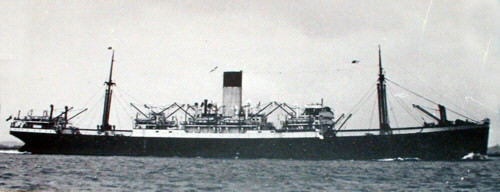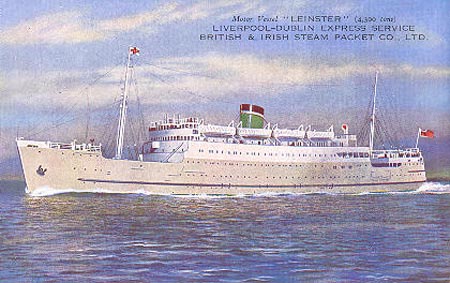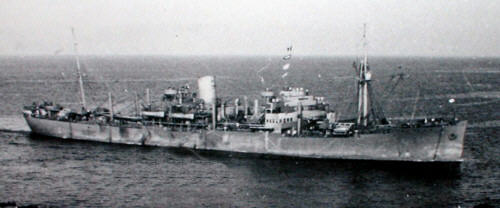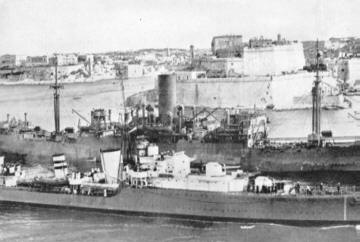|
Planning for this operation commenced in June
1941. It's aim was to resupply Malta from Gibraltar with cover from
Force H as far as the Skerki Channel. The fleet from Alexandria were
tasked with creating a diversion to make the axis powers think the convoy
was heading for Alexandria.
Submarines from Alexandria were sent to the west of Crete to send misleading
radio signals to fool the enemy to thinking their was convoy activity
in the area & lure out attacking forces away from the real area
of operation. This plan worked as aircraft from the Luftwaffe &
Regia Aeronautica were drawn to the area. The battle fleet meanwhile
returned to Alexandria.
The second part of the plan was to escort empty merchantmen lying in
Grand Harbour, Malta back to Gibraltar. The tanker Breconshire
& 6 merchantmen would be part of this return convoy.
Typically cargoes would be split between ships with a bit of everything
so that if ships were lost at least some of all items would get through.
Port Chalmers loading manifest
included:- 2,000 tons of high octane aviation fuel, maize, wheat, flour,
corned beef, mutton, cement, whiskey, tobacco, cigarettes, cotton bales,
guns, shells, ammunition, cars, lorries & aircraft components.
The convoy originated from Greenock, Scotland. It departed around 2
am.
The convoy entered the Straits of Gibraltar on the night of 21st July
1941. Night passages were the norm as many enemy agents would report
shipping movements back to Italian intelligence.
A thick fog covered the Straits & the merchant Leinster
ran aground on the north African mainland at Algeciras. This was land
controlled by Vichy French forces & the danger was that all personnel
& cargo would be impounded. A ship (reportedly a destroyer) came
alongside & took off the personnel, delivering them to Gibraltar
where they were later billeted on the French Liner Louis
Pasteur for a time. Leinster
& the Pasteur failed to make
the convoy.
At the Skerki Channel (the narrows) Force H turned
back to Gibraltar. This was so as not to put capital ships at risk.
The Italian fleet had a considerable force of battleships & heavy
cruisers at hand.
On the 23rd July Manchester was
attacked by 2 Italian torpedo boats (MAS)(No's 16 & 22) & Italian
bombers. She was hit in an oil fuel tank & 2 engines were put out
of action. She returned to Gibraltar for repairs.
Fearless was torpedoed & had
to be sunk by her sister ship Forester.
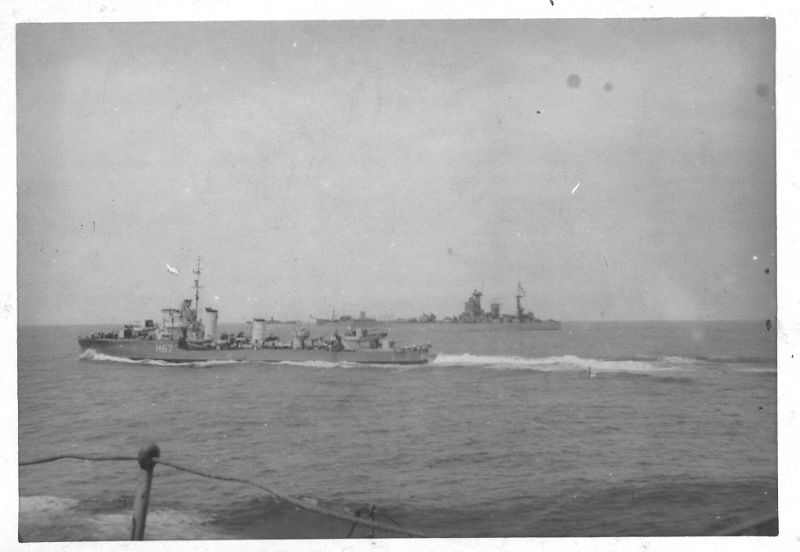
HMS Fearless
in foreground with HMS Nelson
in the background.
Photo courtesy of Tony Cox.
|
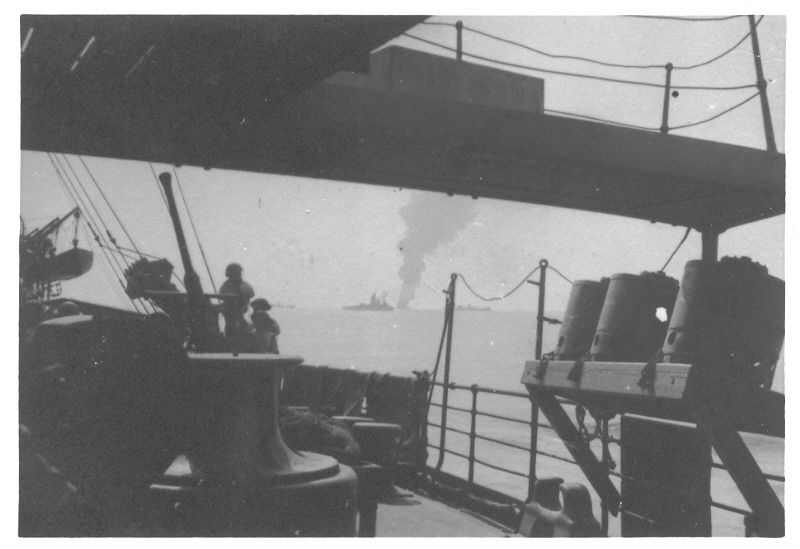
Sinking of HMS
Fearless taken aboard
RA Vessel 'Port Chalmers'
July 23rd 1941
Photo courtesy of Tony Cox.
|
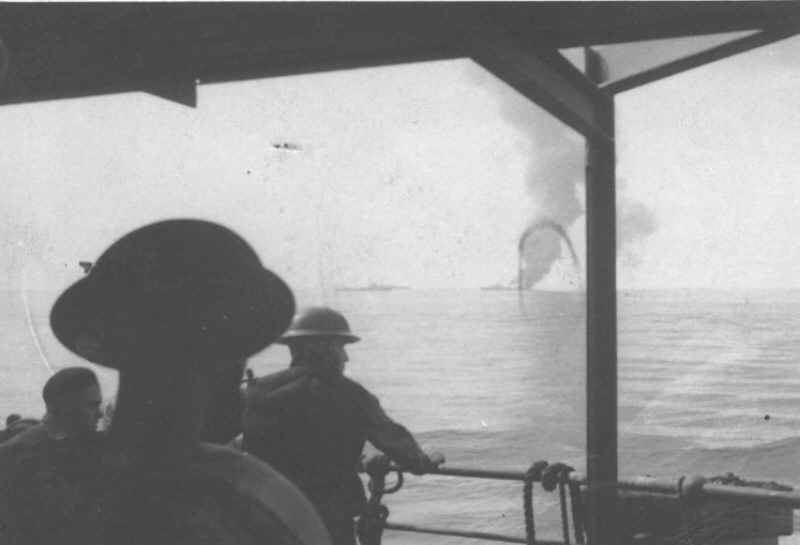
HMS Fearless
on fire 23rd July 1941.
Photo courtesy of Tony Cox.
|
Sydney Star
was torpedoed by an E-boat & sustained a 40 x 20' hole in her
bows. She started to sink by the head & drifted towards the enemy
held island of Pantellaria. HMS Nestor
came alongside & started evacuating the crew & 464 troops
from the 32nd Light AA Regiment. Apart from the personnel her cargo
was grain, naval stores & ammunition. It took about half an hour
to transfer some 500 men. A skeleton crew remained on board &
managed to get 12 knots out of the engines. They set coarse for Malta.
Some Savoia bombers made an attack which was driven off.
Sydney Star by this time was estimated to have shipped
7,000 tons of water & was hard to handle. At 7 am a lone aircraft
attacked with a torpedo which exploded in the ships wake. She was
joined by Hermione,
Nelson &
Beaufighters from Malta & made Valletta harbour at 8 am.
HMS Firedrake
received a direct hit in No. 1 boiler room from a bomb off Cape Bon.
She was taken in tow by a Hunt class destroyer & taken 800 miles
to Gibraltar.
HMS Edinburgh
endured 13 hours of bombing & torpedoes. She was carrying the
11th Battalion Lancashire Fusilliers.
The convoy reached Malta on the 24th
July & was greeted by reconnaissance aircraft from Sicily who
brought up high level bombers to attack to convoy in harbour. This
attack was broken up by the anti-aircraft barrage & Hurricanes.
The fleet returned to Gibraltar
where Leinster & Louis
Pasteur were docked. The personnel previously rescued from
Leinster were transferred to
Arethusa,
Hermione & the minelayer
Manxman. This small force sailed
at top speed for Malta. It was rumoured that Arethusa
& Hermione were expendable
as long as Manxman got through
(ref:Malta Convoy. David A.Thomas pp104). This ship also being loaded
with bombs, torpedoes & supplies.
Next day at daybreak a submarine was seen on the surface off Tunis
& orders were given for Hermione
to ram which she did, hitting the submarine abaft the conning tower.
This was the Italian submarine Tambien
which sank. Hermione sustained
a 20' gash to her bows.
This force got into Malta at 11.30 am, 24th July.
The convoy managed to land 5,000
men, 65,000 tons of stores which included submarine torpedoes, Hurricane
engines, anti-aircraft guns, 10,000 tons of ammunition, edible oils,
sugar, coffee & tea.
|
